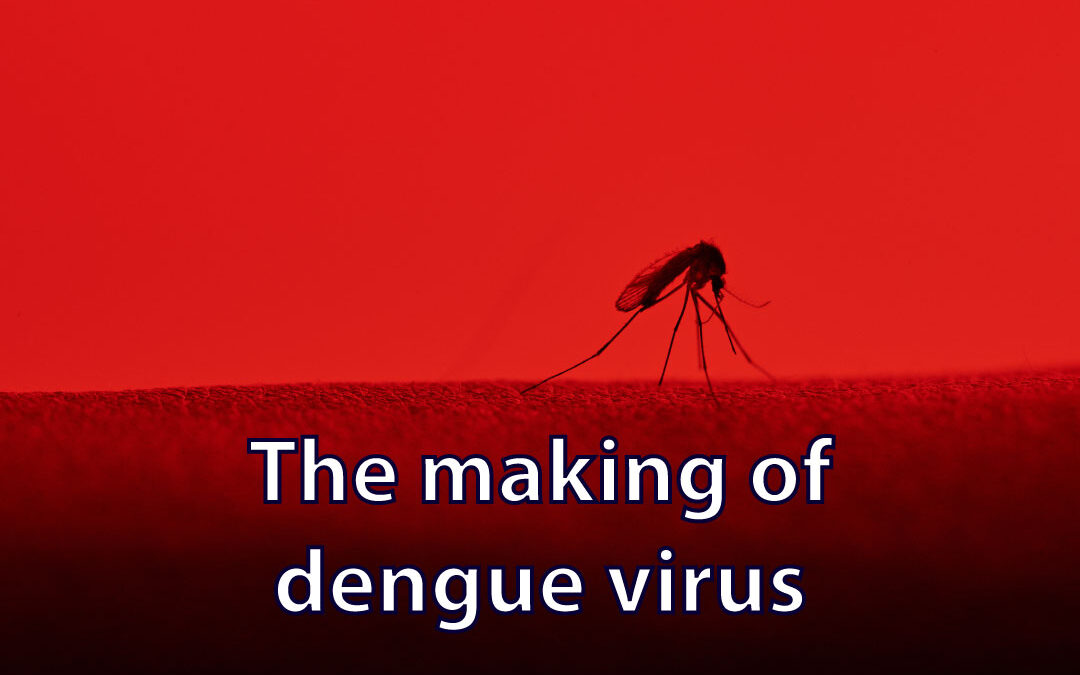A brief jaunt through the dengue life cycle
During DENV entry into the host cell, the envelope protein binds to the cognate receptor and triggers DENV endocytosis and internalization within an endosome. Next, low endosomal pH induces changes in the conformation of the envelope proteins that ultimately leads to the endosome’s membrane and the virus’s membrane fusing together and the release of the capsid into the host cell cytoplasm. The capsid breaks then apart, releasing the viral RNA that finds its way to the rough endoplasmic reticulum.
Here, the RNA recruits translation initiation proteins, attaches to the ribosome, and the whole viral genome is translated as a single, long, poly-protein chain.
These translated DENV proteins are then activated by a combination of host’s proteases and the viral protease NS3, and an RNA replication complex is formed. In a multi-step process, multiple positive sense strand copies of the DENV genome are made, some of which are translated to make more viral proteins. Eventually, enough proteins have been made to assemble new viruses; a viral RNA binds to the capsid protein and is packaged into a new virus particle as it buds off into the endoplasmic reticulum. The virus matures as it travels through the Golgi apparatus and continues toward the cell’s surface from where it’s secreted via exocytosis. In the extracellular space, the pr region of the pre-membrane protein, previously cleaved by furin proteases in the Golgi, is shed from the virus surface completing the maturation of the virus. These new DENV particles are released and, if properly furin cleaved and matured, ready to infect other cells.
Dengue Capsid
Located at the end of the 5′ terminus of the genome, the DENV capsid is the first viral protein synthesized during translation. It is a 12-kDa, 100-residue protein that forms homodimers in solution. The capsid protein is highly basic (26 basic amino acids vs. 3 acidic residues) and has affinity for nucleic acids and lipid membranes. During the infection cycle, newly synthesized RNA genomes associate with the capsid protein to form the nucleocapsid. Despite little sequence conservation with other DENV strains, the capsid contains a conserved internal hydrophobic segment that acts as a membrane anchor domain embedded in the endoplasmic reticulum membrane. The DENV capsid protein is functionally and structurally plastic: in addition to the membrane-bound form, the capsid protein also exists as a soluble, unbound, homodimer that forms helical dimers in solution via a coupled folding-binding mechanism.
Given the importance of the capsid protein in the dengue life cycle, it is an attractive target for anti-DENV small molecules. Indeed, the small-molecule compound ST-148 has been reported as a potent DENV capsid inhibitor (EC50 = 0.052 µM), which enhances capsid-protein interaction and causes steric hindrance and/or structural rigidity that inhibits both the entry and assembly or release of infectious virions.
Dengue prM/M protein
The dengue virus prM is a 166-amino acid glycoprotein. During the maturation process, this protein is cleaved by furin, releasing the N-terminal ‘pr’ polypeptide (residues 1–91), the mature M protein containing the ectodomain (residues 92–130), and the C-terminal transmembrane region (residues 131–166).
The DENV particles can exist in either a mature or immature form, which are morphologically very different from each other. The outer surface of the immature DENV particles is spiky, whereas mature particles are smooth. In the immature form, 90 heterodimers of prM and E extend as 60 trimeric spikes from the particle surface, whereas protein E of the mature form arranges into 90 homodimers that lie flat against the viral surface, forming a smooth protein shell.
The transition between the mature or immature forms of DENV is driven by conformational changes in the viral E and prM/M proteins. The immature virions are protected against premature fusion with the host membrane by the ‘pr’ peptide. During transition from the immature to the mature form, the pr peptide is cleaved from the prM protein, and protein M acts in the mature particle as a transmembrane protein located beneath the E protein shell.
Dengue Envelope
The envelope protein is found on the surface of the dengue virion, where 180 copies contribute to creating DENV’s symmetrical, icosahedral surface. The envelope protein is the first point of contact between the virus and the host cell, and plays a key role in cell entry through the interaction with several host cellular proteins and carbohydrate molecules.
Protein E is a multifunctional protein of about 53 KDa and is composed of three domains: DI, DII, and DIII. Protein flexibility is important during DENV assembly and infection and the E protein is no exception, undergoing extensive conformational changes during the infection process.
Protein E is able to form heterodimers with the prM protein in the immature virion or homodimers in the mature virus.
Being fully exposed to the medium, the E proteins have been considered as the main antigenic target on the DENV surface: indeed, it has been reported that many monoclonal antibodies that bind to E protein strongly neutralize DENV. Given the importance of the envelope protein for the fusion of the virus and endosome membranes during viral entry into the host cell, the envelope protein is an obvious drug target. The small molecules DB00179, Quercetin, Silymarin, Dapagliflozlin, and Fisetin have been identified as candidate inhibitors of the DENV envelope protein, and the 3-110-22 compound can block the envelope protein’s fusion-inducing conformational change.




